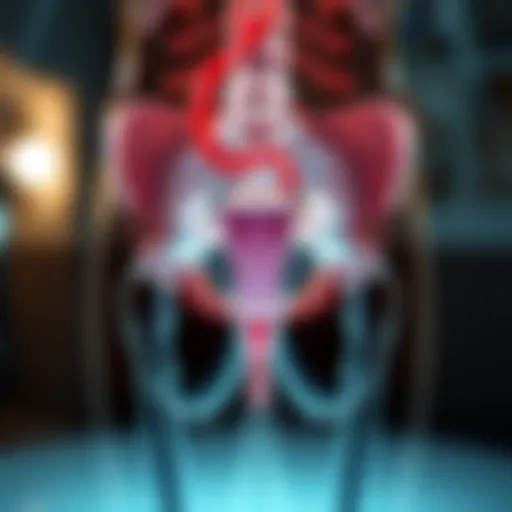Understanding Postpartum Edema: Causes and Management


Summary of Objectives
Postpartum edema is a common experience for many women during the time following childbirth. This article aims to provide a thorough examination of postpartum edema, elucidating why it occurs, its various manifestations, and the potential complications if left unmanaged. Additionally, it discusses effective management strategies, including prevention techniques and indicators for when medical intervention may be necessary.
Importance of the Research
Understanding postpartum edema holds significance for both healthcare professionals and new mothers. Recognizing its physiological roots can lead to more informed decisions about care and recovery. This knowledge is essential to mitigate risks and ensure a supportive recovery after childbirth.
Results and Discussion
Presentation of Findings
Postpartum edema typically results from a combination of hormonal fluctuations, water retention, and changes in blood circulation. The body undergoes significant changes during and after pregnancy. Hormones like progesterone lead to fluid retention, which can contribute to overall swelling. Additionally, increased blood volume during pregnancy may result in the pooling of fluids in the extremities after delivery.
"Postpartum edema can manifest as swelling in the feet, ankles, and hands, often peaking within the first week after delivery."
Implications of Results
The implications for new mothers are multifaceted. While swelling may be a normal part of recovery, it can also signal underlying issues, such as pre-existing conditions or negative reactions to medications. Women should monitor their symptoms and seek medical advice if swelling persists or worsens.
Management Strategies
- Hydration: Adequate fluid intake is crucial in managing fluid balance. Drinking water helps the body to flush out excess sodium and reduce swelling.
- Physical Activity: Gentle movement, including walking or stretching, can promote circulation and help alleviate edema.
- Compression Garments: Wearing compression stockings may provide support and reduce swelling in the legs and feet.
- Rest and Elevation: Keeping feet elevated when resting may reduce fluid accumulation and improve comfort levels.
It is essential for women to recognize when self-care is insufficient. If swelling is accompanied by severe pain, redness, or sudden shortness of breath, medical attention should be sought urgently.
Prologue to Postpartum Edema
Postpartum edema is a significant and often overlooked aspect of recovery following childbirth. Understanding this condition is crucial for those who have recently given birth, healthcare providers, and support systems. The fluid retention which leads to swelling can be a normal response in many cases; however, recognizing its implications is key to ensuring overall health.
The importance of discussing postpartum edema lies in its prevalence. Many women experience some degree of swelling after giving birth, and this can contribute to discomfort and emotional stress. By illuminating the causes, symptoms, and management techniques of this condition, the way is paved for enhanced postpartum recovery.
Key Elements to Consider:
- Physiological Changes: The body undergoes significant transformations during and after pregnancy, and postpartum edema results from these changes. Understanding these shifts in physiology can demystify the experiences women face.
- Health Monitoring: Recognizing when swollen limbs or face may signal underlying issues is vital for timely intervention. It also empowers women to take charge of their health.
- Management Strategies: Knowing effective management techniques can aid in reducing swelling and enhancing comfort. This knowledge, when properly conveyed, plays a critical role in supporting recovery.
By focusing on postpartum edema, readers gain insight into a common yet often misunderstood condition. The discussion emerges from a place of education and a desire to improve wellbeing after the substantial demands of childbirth.
Defining Edema
Defining edema is crucial to understanding the broader picture of postpartum health. Edema refers to swelling caused by excess fluid trapped in your body's tissues. Recognizing its characteristics is important for new mothers as they navigate postpartum recovery. This knowledge not only empowers women to monitor their health but also assists healthcare providers in distinguishing between normal postpartum changes and those that require medical intervention.
What is Edema?
Edema is a medical term for swelling. It can occur in various parts of the body, such as the legs, ankles, and hands. This swelling results from fluid leakage from blood vessels into the surrounding tissues. Generally, it is not a health risk itself, but persistent or severe edema can indicate underlying issues. Many women experience this phenomenon after childbirth due to changes in circulatory dynamics and hormonal influences.
Types of Edema
Understanding the types of edema is essential for managing its effects. Each type offers unique insights into the patient's status.
Localized Edema
Localized edema involves swelling that occurs in a specific area of the body. Common locations include the feet, ankles, or wrists. One key characteristic of localized edema is its response to movement and position; it may worsen after prolonged standing or sitting. This type is a beneficial consideration for postpartum recovery since it typically resolves on its own and can indicate normal physiological changes after childbirth. However, excessive localized swelling can be uncomfortable and might necessitate some lifestyle adjustments.
Generalized Edema
Generalized edema, on the other hand, affects larger areas of the body, giving a more diffuse swollen appearance. It is crucial to recognize this type as it can point to systemic issues, such as heart or kidney problems. The prominent characteristic of generalized edema is that it typically presents as a more severe condition, possibly requiring medical evaluation. Awareness of this type helps in understanding the complexity of postpartum physiology and ensuring timely interventions when necessary. The broad influence on various body systems makes awareness of generalized edema vital for new mothers: it emphasizes the need for careful monitoring during the postpartum period.
Physiological Changes During Pregnancy
Understanding the physiological changes during pregnancy is vital for grasping the concept of postpartum edema. Pregnancy induces various adaptations in a woman’s body to support the developing fetus. These changes not only ensure the health of the baby but also prepare the mother's body for labor and, ultimately, recovery. The effects of these changes can sometimes lead to complications, such as edema, which can linger after childbirth.
Hormonal Influences
Hormones play a significant role in pregnancy. The levels of progesterone and estrogen increase dramatically. Progesterone has a relaxing effect on blood vessels, leading to an increased capacity for blood flow. This mechanism is essential for accommodating the growing demands of the fetus.
Additionally, hormonal changes influence body fluid regulation. The kidneys have to filter more blood than usual. This can lead to increased water retention, which is a common contributor to postpartum edema. The reactions of the body to these hormonal levels are crucial for maintaining a healthy environment for the baby. However, an imbalance can pre-dispose women to exaggerated fluid retention.
Fluid Retention Mechanisms
Fluid retention is another significant factor related to changes during pregnancy. As the pregnancy progresses, blood volume increases to support the growing fetus and prepare for labor. Increased fluid volume can cause swelling, especially in the extremities such as legs and feet.
Some specific mechanisms contributing to postpartum edema include:
- Increased hydrostatic pressure: This is due to the larger blood volume that circulates.
- Lymphatic system changes: The lymphatic system, responsible for draining excess fluid, can be less effective during and after pregnancy. This inefficiency can lead to fluid accumulation.
- Compression of blood vessels: The weight of the uterus can compress pelvic veins, increasing fluid retention in the lower extremities.
Understanding these physiological factors helps in distinguishing normal postpartum edema from potential complications. Knowledge of how the body adapts during pregnancy can empower women to manage their recovery more effectively.
Afterbirth Changes Leading to Edema
Understanding the changes that occur after childbirth is essential to grasp how postpartum edema develops. Various physiological adjustments take place in a woman's body in the immediate weeks following delivery. These changes are largely responsible for the fluid retention and swelling that many women experience. This section will discuss two key factors that contribute significantly to postpartum edema: fluid redistribution and increased capillary permeability.


Fluid Redistribution
After giving birth, a woman's body undergoes considerable fluid redistribution. During pregnancy, women accumulate extra blood volume and fluid as a natural adaptation to support the growing fetus. Once the baby is delivered, the body needs to adjust back to its pre-pregnancy state. This process is often marked by the movement of fluid from the vascular compartment into the surrounding tissues, resulting in swelling.
This redistribution can also affect how fluids are processed by the body. The postpartum period sees a marked decrease in blood pressure as the body attempts to eliminate excess fluid. As fluid shifts into areas like the feet, legs, and possibly the face, women may find that their extremities feel puffy or swollen.
Recognizing this pattern is vital, as it can help new mothers understand the normalcy of these symptoms. They may find relief through simple measures such as elevating the legs or engaging in gentle physical activity, which could facilitate better fluid circulation.
Increased Capillary Permeability
Another contributing factor to postpartum edema is the increase in capillary permeability that occurs after childbirth. When a woman gives birth, her hormones undergo rapid changes that can affect blood vessels. Increased capillary permeability means that fluid can leak more easily from the bloodstream into surrounding tissue spaces.
This heightened permeability is often a response to the inflammation that can accompany the delivery process. While this response is part of the body's healing mechanism, it can also lead to fluid accumulation and swelling in various regions of the body.
Additionally, hormonal fluctuations, specifically in estrogen and progesterone levels, can exacerbate these effects. For many women, this results in a feeling of fullness or heaviness in their limbs, particularly in the days and weeks following delivery.
"Understanding these physiological changes sheds light on the normalcy of postpartum edema, alleviating concerns for many new mothers."
Common Symptoms of Postpartum Edema
Postpartum edema is not merely a cosmetic concern; it is a physiological response many women experience after childbirth. Understanding the symptoms associated with this condition is crucial for women as they recover from childbirth. Recognizing these symptoms helps in differentiating normal recovery processes from potential complications, ensuring that appropriate care is sought when necessary.
Swelling in Extremities
One of the primary symptoms of postpartum edema is swelling in the extremities, especially in the legs and feet. This swelling can often be attributed to fluid retention, which is a common occurrence after delivery. The mechanism behind this lies in the body's need to adjust the fluid balance following birth. Increased fluid volume helps in healing but can also lead to noticeable signs of edema.
Swelling may exacerbate throughout the day and may be more pronounced during prolonged periods of standing or sitting. For many women, elevating their legs and engaging in light physical activity can alleviate some discomfort.
Key considerations include:
- Frequency: If swelling is mild and gradual, it is often considered normal. However, sudden onset of severe swelling should not be ignored.
- Duration: Edema that persists beyond the initial weeks postpartum may warrant further evaluation.
Facial Edema
Facial edema often attracts significant attention due to its visible nature. Swelling may occur around the eyes, cheeks, and forehead. This symptom typically results from fluid accumulation and increased vascular permeability, which can be a remnant of the hormonal changes that occurred during pregnancy.
Similar to extremity swelling, facial edema can worsen as the day progresses and can be particularly noticeable in the morning. While some degree of facial swelling may be expected, persistent edema or swelling that appears rapidly should be assessed by a medical professional.
Important aspects to consider include:
- Cosmetic Concerns: While facial edema may not pose a health risk, its emotional impact can be significant for new mothers.
- Health Signals: Significant facial swelling could suggest other underlying conditions such as hypertension. Seeking a professional assessment is advisable when swelling appears extreme or is accompanied by other symptoms.
Understanding these common symptoms not only aids in recognizing normal postpartum experiences but also underscores when it is essential to seek medical attention. Getting timely support can play a vital role in the overall recovery process.
When is Edema Normal?
Understanding when edema is considered normal after childbirth is crucial for new mothers. This topic serves to reassure women experiencing this condition while also providing necessary insights into their recovery progress. Distinguishing normal postpartum edema from symptoms that may signal complications can greatly influence a woman's health journey.
Duration of Postpartum Edema
In the days and weeks following delivery, many women will notice varying degrees of swelling. Typically, postpartum edema can last for several days to weeks. Generally, it is not unusual for swelling to peak within the first week. The duration often correlates with individual fluid retention patterns, hormonal fluctuations, and the impact of physical activity. As a guideline, if the swelling persists for more than three weeks, it may warrant further investigation.
"Swelling that continues well beyond the expected time frame should not be ignored. It's essential for women to be mindful of their body's response post-delivery."
Comparison with Other Conditions
Recognizing the difference between normal postpartum edema and other medical conditions is fundamental. For instance, when swelling is accompanied by severe headaches, visual disturbances, or sharp abdominal pain, it could indicate issues such as preeclampsia or deep vein thrombosis.
To avoid confusion, the following points highlight key characteristics:
- Normal Edema: Typically appears in the legs and feet; often resolves on its own; may fluctuate in degree.
- Preeclampsia: Characterized by high blood pressure; presents with sudden swelling; requires immediate medical attention.
- Deep Vein Thrombosis: Associated with intense pain and swelling in one leg; may feel warm to touch; necessitates prompt evaluation.
It is imperative for new mothers to closely monitor their symptoms and consult health professionals when any unusual signs arise. Accurate knowledge empowers women and supports their postpartum journey.
Potential Complications of Postpartum Edema
Postpartum edema, while often a temporary condition, can lead to potential complications that warrant attention. This section outlines the importance and implications of postpartum edema, examining how it can affect women's physical health and quality of life. Recognizing these complications is critical for early intervention and effective management. Failure to address postpartum edema may exacerbate existing health issues or create new ones, impacting recovery.
Infection Risk
One significant complication of postpartum edema is the increased risk of infection. Edema can lead to poor circulation and stagnation of fluids, creating an environment conducive to bacterial growth. Women with swollen extremities may experience skin breakdown, particularly in areas where skin folds occur, increasing vulnerability to infections like cellulitis.
It is essential to monitor any signs of infection, including:
- Redness in the affected area
- Warmth to the touch
- Swelling that does not improve
- Fever or chills
Prompt recognition and treatment are necessary. If treated early, many infections can be managed effectively. However, untreated infections can lead to systemic issues requiring hospitalization and prolonged recovery.
Impact on Mobility
Postpartum edema can substantially impact a woman's mobility. Swelling in the legs and feet can cause discomfort, making it difficult for new mothers to engage in daily activities. This reduced mobility may hinder recovery, as physical activity is often recommended for healing post childbirth.
Difficulties in mobility can manifest in several ways:


- Limited ability to walk or stand without discomfort
- Challenges in caring for the newborn due to fatigue from swelling
- Increased risk of falls, especially when swelling impairs balance
Addressing mobility issues is crucial. Gentle exercises, stretching, and physical therapy can help alleviate discomfort related to edema. Encouraging movement not only supports recovery but also promotes overall well-being during this transitional phase.
Management Strategies for Postpartum Edema
The management of postpartum edema is crucial for many reasons. First, effective strategies can significantly reduce symptoms and discomfort associated with swelling. Proper management can improve overall well-being and motivate women to engage more fully in their recovery journey after childbirth. Furthermore, understanding how to manage postpartum edema can help prevent the condition from causing further complications. Below, we will explore specific methods to manage this condition effectively, addressing physical activity, dietary needs, and proper hydration techniques.
Physical Activity Recommendations
Engaging in suitable physical activity plays an important role in minimizing postpartum edema. Light exercises, such as walking, can enhance circulation. This helps to reduce fluid retention in the limbs, as movement encourages blood flow through the veins. However, it is important to tailor exercise to the individual's condition. Always consult a healthcare provider before starting a new exercise routine.
Some recommended activities may include:
- Gentle stretching: This can help ease tension in muscles and improve flexibility.
- Postpartum yoga: Focuses on breathing and relaxation while promoting light movement.
- Kegel exercises: Beneficial for pelvic health and recovery.
Women should listen to their bodies. If pain or severe discomfort arises, it is better to stop and rest. It is essential to achieve a balance between being active and allowing the body to recover, as overexertion could exacerbate swelling.
Dietary Adjustments
Dietary choices can significantly impact edema management. Certain foods either promote or reduce fluid retention in the body. A well-balanced diet rich in specific nutrients helps improve health overall.
Consider making these adjustments:
- Increase potassium intake: Foods high in potassium, like bananas and sweet potatoes, can help balance sodium levels, which may reduce swelling.
- Limit processed foods: Packaged foods often contain excess sodium, which can worsen edema.
- Incorporate leafy greens: Spinach and kale are excellent sources of vitamins and minerals that promote overall well-being.
- Stay informed about food types: Spices such as ginger and turmeric may help with inflammation.
Ensuring a nutrient-rich diet can influence how effectively the body manages fluid levels.
Hydration Strategies
Staying properly hydrated is essential. While it may seem counterintuitive to drink more water when experiencing edema, proper hydration can help flush out excess sodium. This can decrease fluid retention over time.
- Consistent water intake: Aim for at least eight glasses per day, focusing on hydration.
- Maintain electrolyte balance: Consider beverages that replenish electrolytes, especially if you are active. Options include coconut water or oral rehydration solutions.
- Herbal teas: Some herbal teas, such as dandelion tea, are thought to help with fluid balance, though consult with a doctor before trying.
In summary, managing postpartum edema involves a multifaceted approach. Physical activity, dietary adjustments, and proper hydration provide tangible benefits. Monitoring progress continuously and seeking professional guidance when needed is vital to navigate this stage of recovery effectively.
"Understanding your body during postpartum recovery is essential in managing conditions like edema effectively."
By implementing these strategies, individuals can equip themselves to handle postpartum edema. This can lead to not only a more comfortable recovery but also a better transition into motherhood.
When to Seek Medical Attention
Recognizing when to seek medical attention for postpartum edema is essential. It is normal for many women to experience some degree of edema after childbirth due to hormonal changes and fluid retention. However, certain signs and symptoms can indicate that a more serious underlying issue may exist. Knowing these warning signs and understanding the consultation process can aid in timely interventions.
Warning Signs
Women should be vigilant for certain warning signs that may necessitate medical evaluation. These include:
- Severe Swelling: If the swelling becomes extreme, especially in the legs or feet, this may indicate a problem.
- Shortness of Breath: Difficulty breathing can be a symptom of a serious condition, such as pulmonary edema. This requires immediate attention.
- Chest Pain: Sudden chest pain should never be ignored. It could signify a pulmonary embolism or other cardiovascular issues.
- Persistent Headaches: If headaches do not respond to standard pain relief methods, further assessment may be needed.
- Changes in Vision: Blurred or altered vision can signal hypertension, which may lead to complications like eclampsia.
These symptoms, in conjunction with the general swelling expected postpartum, should prompt further investigation by a healthcare professional.
"Prompt attention to these warning signs can prevent complications and ensure better health for both mother and baby."
Consultation Process
If warning signs are present, it is important to determine the next steps in the consultation process. Here are key aspects to consider:
- Initial Assessment: Contact a healthcare provider, share symptoms clearly, and discuss the timeline of events to give context.
- Physical Examination: The healthcare professional will likely conduct a physical exam to assess the degree of swelling and associated symptoms.
- Diagnostic Tests: Depending on the symptoms, tests such as blood pressure monitoring, blood tests, or imaging studies might be needed. These can help in diagnosing conditions like hypertension or heart issues.
- Follow-Up Plans: Based on the findings, a follow-up plan may be established. It could involve monitoring at home, lifestyle adjustments, or potential treatments.
- Patient Education: Understanding what to look for in terms of changes and long-term management can help women feel empowered in their care.
Timely consultation can make a difference. Being proactive and aware ensures that postpartum recovery is safe and manageable.
Psychosocial Implications of Postpartum Edema
Understanding the psychosocial implications of postpartum edema is essential in comprehending how this physiological condition affects women beyond physical symptoms. Edema can have a profound impact, influencing emotional well-being, self-image, and social interactions. Women experiencing swelling may feel a sense of loss regarding their pre-pregnancy body image. This sentiment can lead to various psychological challenges, impacting their mental health during a crucial recovery period.
Unlike many physical complications, the emotional impact is often not visibly recognized by others, which can lead to feelings of isolation. Women may think their experiences are unique, fostering anxiety or mood disorders that can complicate their ability to bond with their newborn.
Awareness and understanding of these psychosocial dynamics play a vital role. Training healthcare providers to recognize the emotional toll of postpartum edema and encouraging open dialogues can facilitate better support for affected women. This consideration can improve recovery experiences significantly.
Emotional Impact
Postpartum edema can lead to heightened emotions, compounding the stress of new motherhood. Women may experience feelings of frustration when they compare their postpartum bodies to what they once were. This can generate feelings of inadequacy or even depression, particularly if healthcare discussions fail to address their emotional concerns.
Common emotional responses include:
- Frustration: Women may feel trapped in their bodies as swelling persists.
- Anxiety: Worries about body image or health complications may arise.
- Isolation: Feeling misunderstood by peers or family can lead to loneliness.
It becomes crucial to create supportive environments where women can express their struggles. Recognizing that these feelings are valid can help foster a community for new mothers tackling similar challenges.
Coping Mechanisms


To address the emotional toll of postpartum edema, effective coping mechanisms must be identified and encouraged. Strategies can encompass both psychological and physical aspects, aiming to alleviate discomfort and promote emotional resilience.
Suggested coping strategies include:
- Engaging in physical activity: Light exercises can enhance mood and reduce symptoms, but they should be tailored to individual comfort levels.
- Mindfulness and relaxation: Techniques like yoga or meditation can help manage stressors associated with body image issues.
- Support groups: Connecting with other women experiencing similar challenges can reduce feelings of isolation and stigma.
- Professional help: Therapy or counseling can provide structured support for those struggling with intense emotions.
Understanding the psychosocial implications of postpartum edema fosters a holistic approach to care. Acknowledging feelings, offering resources, and building supportive networks can enhance the recovery journey for new mothers.
"Mental well-being is as crucial as physical health during the postpartum period; addressing both fosters a healthier recovery overall."
By implementing these coping strategies, women can navigate the emotional landscape of postpartum edema more effectively, ultimately leading to a smoother transition into motherhood.
Historical Perspectives on Postpartum Edema
Understanding postpartum edema requires a glimpse into its historical context. This section outlines the evolution of perceptions surrounding postpartum edema, shedding light on how earlier beliefs and practices shaped our current understanding. Recognizing past interpretations also highlights the benefits realized through time, as well as the ongoing need for research and skepticism in the face of new theories.
Traditional Understanding
Historically, postpartum edema was often viewed through a lens of superstition and folklore. Many cultures believed that the swelling of limbs and face after childbirth was a punishment or a result of an imbalance in the body's humors. For instance, ancient medical texts suggested that new mothers should adhere to strict dietary restrictions to counteract the perceived dangers of retained fluids. Traditional remedies varied greatly by region, ranging from herbal infusions to specific physical rituals aimed at expelling excess fluids.
This traditional understanding informed societal attitudes towards postpartum women, often stigmatizing natural bodily changes as signs of weakness or poor health. Health practitioners in those times lacked the medical knowledge to link swelling to physiological changes from childbirth, thus reinforcing misconceptions about a woman's recovery.
Modern Advances in Research
In recent decades, the understanding of postpartum edema has shifted dramatically due to advancements in medical research. Studies have revealed the physiological mechanisms driving swelling after childbirth, such as increased capillary permeability and hormonal fluctuations. With medical imaging and laboratory testing, researchers have clarified the normal physiological processes associated with postpartum recovery.
Modern literature, including peer-reviewed articles, emphasizes the importance of distinguishing between normal postpartum edema and symptoms that signal more severe health issues. Professionals now recognize that while postpartum edema can be distressing, it is typically a temporary condition that resolves with proper management.
"The evolution from traditional remedies to evidence-based practice illustrates the significant strides in understanding postpartum physiology."
Current research continues to explore the long-term effects of postpartum edema on maternal health and quality of life, which were previously overlooked. The integration of scientific methods in studying postpartum conditions has enhanced the ability to develop comprehensive management strategies tailored to individual needs. Understanding the past informs the present, ensuring that new mothers receive informed care reflective of their experiences.
Case Studies on Postpartum Edema
Examining case studies related to postpartum edema is critical in understanding this condition in real-world contexts. These instances provide insight into the diversity of experiences women may face during the postpartum period. Moreover, they highlight the importance of personalized care and the variations in recovery processes. Understanding these differences can be beneficial for healthcare providers and affected individuals alike. By analyzing notable instances, we can better appreciate the complexities of postpartum edema and its implications for women's health.
Notable Instances
Consider the case of a woman named Sarah, who experienced significant swelling in her legs and feet shortly after giving birth. Sarah's situation was compounded by an unanticipated length of recovery time. Initial assessments indicated typical postpartum edema due to hormonal changes; however, her condition took longer to resolve than expected. This drew attention to possible underlying issues such as a potential kidney dysfunction. Sarah’s healthcare team implemented a comprehensive management approach that included reassessing her fluids and electing to closely monitor her renal function.
In another case, Maria displayed facial edema that drew concern. Her swelling appeared not just noticeable but uncomfortable, affecting her ability to eat properly. Following consultation, Maria's care team focused on managing both her swelling and ensuring she felt supported emotionally. By engaging with a nutritionist and physical therapist, they created a tailored plan for gradual recovery. Such experiences reveal the varying manifestations of postpartum edema, highlighting that no two cases are precisely the same.
Learning from Experience
Learning from these case studies serves multiple purposes. Firstly, they reinforce the necessity of individualized care plans. Each woman’s physiological response to pregnancy and childbirth may differ, making it crucial for healthcare professionals to take personal histories into account. Secondly, these instances provide education on potential complications associated with postpartum edema, prompting timely intervention.
Through Sarah’s and Maria’s experiences, healthcare practitioners can refine their screening and assessment processes, ensuring they address every aspect of postpartum care effectively. These case studies can also help in confirming best practices and developing guidelines that prioritize the health and well-being of postpartum individuals.
“Case studies bridge the gap between theory and practice, illuminating areas where conventional wisdom may fall short in addressing unique health issues.”
By documenting and analyzing such experiences, professionals can contribute to an evidence-based approach that improves outcomes for women navigating postpartum edema. Understanding these narratives inspires ongoing learning and better care standards, which is essential for advancing maternal health.
Future Research on Postpartum Edema
Postpartum edema is a complex condition. Despite its prevalence, many aspects remain inadequately understood. This section discusses the importance of future research into postpartum edema, underscoring the need for targeted studies to shed light on its causes, effects, and management practices. This research is vital as it will not only enhance clinical practices but also improve the overall experience of new mothers during recovery.
Research in this area can focus on multiple elements:
- Detailed studies on the physiological factors contributing to postpartum edema.
- Investigation into effective preventive measures and management strategies.
- Exploring the psychological impact of edema, thus broadening the understanding of how it affects emotional well-being.
Increased funding and collaboration among researchers could lead to discoveries that might transform current practices in managing postpartum edema. By addressing existing gaps in knowledge, future studies can provide valuable insights for healthcare professionals.
Gaps in Current Knowledge
Significant gaps still exist in our understanding of postpartum edema. Many aspects remain unclear, which hampers effective clinical decision-making. Some critical areas requiring attention include:
- Understanding Individual Variability: How do factors like genetics, lifestyle, and pre-existing conditions affect the severity and duration of edema?
- Longitudinal Studies: There is a lack of long-term data about postpartum edema, particularly how it might correlate with long-term health outcomes.
- Causative Mechanisms: While some physiological causes are known, the complete range of biological mechanisms leading to edema are still being investigated.
Moreover, the interplay between postpartum edema and other health issues warrants deeper examination. This knowledge can lead to more personalized and effective care strategies, ultimately improving healing and comfort for patients.
Emerging Studies
Several emerging studies point toward a progressive understanding of postpartum edema. These initiatives are promising developments within medical literature. Increasingly, researchers are:
- Examining Lifestyle Influence: Recent studies have begun investigating how diet and exercise affect the incidence and duration of postpartum edema.
- Technology Utilization: New technologies, like wearable devices, are being employed to gather data on fluid retention and maternal health indicators. These tools can help create more tailored care programs.
- Psychosocial Research: Research is also moving in the direction of understanding how postpartum edema impacts psychological health, particularly issues such as postpartum depression.
With the foundation of these studies, we can anticipate a more enriched understanding of postpartum edema. This knowledge will lead to refined clinical guidelines and approaches in the management of this condition. Future research remains crucial to address postpartum edema effectively, offering hope and improved care for new mothers.
Ending
In summary, understanding postpartum edema is crucial for both physical and emotional well-being after childbirth. This article highlights the primary causes, visible effects, and effective management strategies for this common condition. Postpartum edema, while often a benign occurrence, can lead to complicating factors if not monitored appropriately.
Recognizing the differences between normal and concerning edema can significantly impact recovery for new mothers. Attention should be paid to signs of excessive swelling, particularly when accompanied by other symptoms such as pain or fever, which may indicate underlying issues.
A proper understanding of postpartum edema allows women to address their health concerns early, promoting better recovery outcomes.
The benefits of proactive management include improved comfort, enhanced mobility, and reduced risk of complications. In addition, this knowledge empowers new mothers to confidently navigate consultations with healthcare professionals when necessary. Careful attention to hydration, diet, and activity levels can aid in alleviating symptoms.
Overall, by synthesizing various elements discussed throughout the article, we aim to provide a comprehensive framework for addressing postpartum edema, fostering a supportive environment for recovery. This understanding serves not only as a means to manage physical symptoms but also plays a vital role in emotional well-being during a delicate transition in life.















